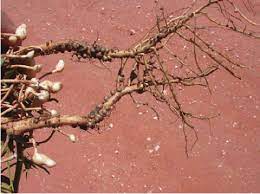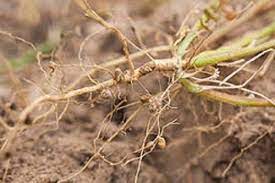Groundnuts/Peanuts Lateral roots also known as peanuts (Arachis hypogaea), are leguminous plants that produce edible seeds, commonly consumed as nuts. Like most plants, groundnuts have a root system that plays a crucial role in anchoring the plant, absorbing water and nutrients from the soil, and supporting overall growth and development. The root system of groundnuts consists of various types of roots, including lateral roots.
Lateral roots, also referred to as secondary roots or branch roots, are a critical component of the root system. They originate from the primary or taproot and spread horizontally in the soil away from the main stem. These roots develop laterally in response to environmental cues and the need for efficient water and nutrient absorption.
Lateral roots exhibit a branching pattern, forming multiple side branches from the primary root. This branching system allows the plant to explore a larger volume of soil, increasing the surface area for water and nutrient uptake.
The primary function of lateral roots is to absorb water and nutrients from the surrounding soil. They are responsible for taking up essential minerals, such as nitrogen, phosphorus, potassium, and other micronutrients necessary for the plant’s growth and development.
An addition to lateral roots branching from the primary root, groundnuts can also develop adventitious roots. Adventitious roots are roots that emerge from stems or other non-root plant parts. In groundnuts, adventitious roots may form on lower nodes of the stem and also contribute to water and nutrient uptake.
Lateral roots, along with the taproot, can also serve as storage sites for carbohydrates and other nutrients, which the plant can utilize during periods of stress or to support reproductive processes, such as seed development.
Groundnuts, like other legumes, have a unique ability to form a symbiotic relationship with nitrogen-fixing bacteria called rhizobia. These bacteria reside in specialized structures called nodules on the lateral roots. They convert atmospheric nitrogen into a form that the plant can use, thereby enhancing the soil’s fertility and reducing the plant’s dependence on external nitrogen sources.
The growth and branching pattern of lateral roots can be influenced by various environmental factors, such as soil moisture, nutrient availability, and the presence of obstacles in the soil. For example, when moisture is scarce, lateral roots may grow more extensively in search of water.
The Economic Importance and Uses of Groundnuts/Peanuts Lateral roots

While the main focus is usually on the aerial parts of the plant (stems, leaves, and pods), lateral roots also play a crucial role in the plant’s overall economic importance and various applications.
Here are some of the economic uses and importance of groundnut lateral roots:
1. Soil erosion prevention: Lateral roots help stabilize the soil by binding it together, which reduces soil erosion. This is particularly important in regions with sandy or loose soils where erosion is a significant concern.
2. Nutrient uptake: Lateral roots are responsible for absorbing water and essential nutrients from the soil. They play a key role in the efficient uptake of nutrients, contributing to the plant’s overall health and productivity.
3. Nitrogen fixation: Some leguminous plants, including groundnuts, have symbiotic relationships with nitrogen-fixing bacteria called Rhizobia. These bacteria reside in specialized nodules on the lateral roots, converting atmospheric nitrogen into a usable form for the plant. This process enriches the soil with nitrogen, benefiting not only groundnuts but also other crops grown in rotation.
4. Drought tolerance: Groundnut lateral roots can grow deep into the soil, accessing moisture reserves even during periods of drought. This ability to reach deeper water sources enhances the plant’s resilience to dry conditions, making it an important crop in arid regions.
Read Also: Economic Importance, Uses, and By-Products of Groundnuts/Peanuts Cotyledons
5. Carbon sequestration: Groundnut lateral roots contribute to carbon sequestration by storing carbon in the soil in the form of organic matter. This helps mitigate climate change by reducing atmospheric carbon dioxide levels.
6. Crop rotation and soil improvement: As a leguminous plant, groundnuts can be included in crop rotation systems to improve soil health. The nitrogen-fixing ability of groundnut lateral roots enriches the soil, benefiting subsequent crops that follow in the rotation.
7. Livestock feed: While groundnut lateral roots are not as commonly used for livestock feed as other parts of the plant, they still hold some nutritional value and can be used as fodder in times of scarcity.
8. Medicinal uses: Some traditional medicine practices use groundnut lateral roots for various medicinal purposes. They are believed to have anti-inflammatory properties and may be used in herbal remedies for certain ailments.
Example: In certain regions, groundnut crop residues, including lateral roots, are left in the fields after harvest to improve soil fertility. These residues break down over time, adding organic matter and nutrients to the soil, benefiting the subsequent crop in the rotation.
9. Culinary uses: While not as commonly known for culinary purposes as peanuts themselves, groundnut lateral roots can still be used in certain regional cuisines. In some cultures, they may be boiled, roasted, or ground into flour and used as an ingredient in various dishes.
Example: In certain parts of Africa, groundnut lateral roots are used to prepare traditional dishes. They may be boiled and seasoned with spices to create a nutritious and flavorful side dish.
10. Biodiesel production: Groundnut oil extracted from the seeds is a valuable source of biodiesel. While the primary focus is on the oil content of the seeds, any other parts of the plant, including lateral roots, may also contribute to oil production.
11. Biomass energy: The aerial parts of groundnut plants, including lateral roots, can be used as a source of biomass energy. They can be converted into biofuels, biogas, or used directly as a fuel source for cooking or heating.
12. Soil improvement for reclamation projects: In degraded or marginal lands, groundnut cultivation, including the lateral roots, can be employed as a soil improvement strategy during reclamation projects. The deep root system helps improve soil structure and fertility, making the land more suitable for further agricultural or ecological restoration efforts.
Example: Groundnut lateral roots could be used in land reclamation initiatives to rehabilitate areas affected by mining activities or degraded by other anthropogenic factors. Their ability to fix nitrogen and enhance soil structure would aid in the restoration process.
13. Industrial applications: Beyond the culinary uses and oil extraction from peanuts, groundnut lateral roots may have potential industrial applications. Research into utilizing the byproducts of groundnut cultivation, such as lateral roots, for bio-based materials, bio-plastics, or bio-composites, could open up new economic opportunities.
The Products and By-products That Can Be Derived From Groundnuts/Peanuts Lateral roots

Groundnuts, also known as peanuts, are a valuable source of various products and by-products that can be derived from their lateral roots. Lateral roots are the secondary roots that branch off from the main taproot and play an essential role in nutrient absorption and anchoring the plant. While groundnuts are primarily cultivated for their seeds, lateral roots also offer a range of uses.
Here are some products and by-products derived from groundnuts’ lateral roots:
1. Groundnut Oil: Groundnut oil is the primary product obtained from the lateral roots of groundnuts. The roots contain oil-rich tissues that can be extracted through a process known as solvent extraction or cold pressing. Groundnut oil is widely used for cooking purposes due to its high smoke point and nutty flavor. It is also used in the manufacture of cosmetics and pharmaceuticals.
2. Groundnut Cake: After extracting oil from the lateral roots, the remaining residue is known as groundnut cake or meal. This cake is rich in protein and can be used as a valuable component in animal feed, especially for cattle, poultry, and fish.
3. Biofuels: Groundnut lateral roots can also be utilized for the production of biofuels, such as biodiesel and biogas. The oil extracted from the roots can be converted into biodiesel, which is a renewable alternative to conventional diesel. Additionally, groundnut cake can be used in biogas production through anaerobic digestion, providing a sustainable source of energy.
4. Fertilizers and Soil Amendments: The residual groundnut cake, after oil extraction, can be further processed and used as an organic fertilizer or soil amendment. It enhances soil fertility by providing essential nutrients like nitrogen, phosphorus, and potassium to the soil.
Read Also: Economic Importance, Uses, and By-Products of Groundnuts/Peanuts Leaves
5. Pharmaceuticals and Nutraceuticals: Groundnut lateral roots contain various bioactive compounds with potential health benefits. These compounds can be extracted and utilized in the pharmaceutical and nutraceutical industries for the development of medicines, supplements, and functional foods.
6. Dyes and Pigments: Groundnut lateral roots may contain natural dyes and pigments that can be extracted and used in various industries, such as textiles, cosmetics, and food coloring.
7. Phytochemical Extraction: Phytochemicals are biologically active compounds found in plants. The lateral roots of groundnuts can serve as a source of phytochemicals, which have antioxidant, antimicrobial, and other beneficial properties. These compounds can be extracted and used in various industries like cosmetics and dietary supplements.
8. Biodegradable Plastics: Groundnut lateral roots contain compounds that can be used in the production of biodegradable plastics. These plastics offer an eco-friendly alternative to conventional plastics derived from fossil fuels.
9. Cosmetics and Skincare Products: Extracts from groundnut lateral roots can be used in cosmetics and skincare products due to their moisturizing and nourishing properties. They can be incorporated into creams, lotions, and hair care products to enhance their effectiveness.
10. Phytoremediation: Groundnut plants, including their lateral roots, have the ability to absorb heavy metals and other pollutants from the soil. This process is known as phytoremediation. Groundnuts can be cultivated in contaminated areas to help detoxify the soil and water.
11. Traditional Medicine: In some traditional medicinal practices, groundnut lateral roots are used for their therapeutic properties. They are believed to have anti-inflammatory, analgesic, and other medicinal effects. However, the efficacy and safety of these uses require scientific validation.
12. Food Additives: Extracts from groundnut lateral roots can be utilized as natural food additives to enhance flavors, colors, and nutritional content in various food products.
Processes for deriving these products and by-products involve specialized extraction techniques, refining, and purification to obtain the desired compounds in their purest form. Some applications, such as biodegradable plastics, may require additional chemical transformations to produce the final product.
It is important to consider sustainability and environmental impact when utilizing groundnut lateral roots for various purposes. Practices such as crop rotation, soil conservation, and responsible waste management can help maintain the soil health and ecosystem balance. Furthermore, research and innovation in the field of groundnut lateral root utilization are ongoing, and new applications may emerge as technology and understanding of plant chemistry advance.
In conclusion, groundnut lateral roots provide a diverse range of products and by-products that contribute to various industries, including food, agriculture, energy, and pharmaceuticals. By harnessing these resources responsibly, we can maximize the benefits of groundnut cultivation while minimizing environmental impacts.
Read Also: Amazing Benefits of Precision Agriculture
